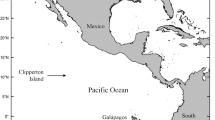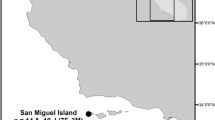Abstract
Total mercury concentrations were determined in samples of body feathers from a range of common seabird species breeding at L»trabjarg, northwest Iceland, St. Kilda, Foula and the Firth of Forth, Scotland and Bleiksøy, Syltefjord, and Hornøy, Norway. Seabirds from L»trabjarg generally exhibited the highest mercury concentrations, with a trend of decreasing mercury concentrations in a southwest to northeast direction in seabirds at the other colonies; seabirds at Hornøy were generally found to have the lowest mercury concentrations. Some species at the Firth of Forth exhibited relatively elevated mercury concentrations compared to those at Foula and Norwegian sites. Inter-colony differences in diet were thought to be relatively small for most species and unlikely to account for the range of mercury concentrations measured in the seabirds (L»trabjarg: lowest arithmetic mean mercury concentration in common guillemots Uria aalge, 1.6 μg/g, s.d.=0.6, n=45; highest arithmetic mean mercury concentration in kittiwakes Rissa tridactyla, 5.5 μg/g, s.d.=1.7, n=36). The oceanic transport of mercury, together with the effects of anthropogenic inputs of mercury to the northeast Atlantic, and the removal of mercury from the water column via biological activity are discussed as influential factors determining the observed patterns of mercury concentration in seabirds.
Similar content being viewed by others
References
Appelquist H, Asbirk S, Drabaek I (1984) Mercury monitoring: Mercury stability in bird feathers. Mar Pollut Bull 15:22–24
Barrett RT, Anker-Nilssen T, Rikardsen F, Valde K, Røv N, Vader W (1987) The food, growth and fledging success of Norwegian puffin chicks Fratercula arctica in 1980–1983. Ornis Scand 18:73–83
Barrett RT, Furness RW (1990) The prey and diving depths of seabirds on Hornøy, north Norway after a decrease in the Barents Sea capelin stocks. Ornis Scand 21:179–186
Barrett RT, Skaare JU, Norheim G, Vader W, Frøslie A (1985) Persistent organochlorines and mercury in eggs of Norwegian seabirds 1983. Environ Pollut (A) 39:79–93
Becker PH (1989) Seabirds as monitor organisms of contaminants along the German North Sea coast. Helgolander Meer 43:395–403
Becker PH, Conrad B, Sperveslage H (1989) Chlororganische Verbindungen und Schwermetalle in Weiblichen Silbermöwen (Larus argentatus) und ihren Eiern mit bekannter Legefolge. Die Vogelwarte 35:1–10
Becker PH, Ternes W, Rüssel HA (1985) Schadstoffe in Gelegen von Brutvögeln der deutschen Nordseeküste. II. Quecksilber. J Orn 126:253–262
Blake BR, Tasker ML, Hope Jones P, Dixon TJ, Mitchell R, Langslow DR (1984) Seabird distribution in the North Sea. Nature Conservancy Council, Huntingdon, Cambridgeshire
Bradstreet MSW, Brown RGB (1985) Feeding ecology of the Atlantic Alcidae. In: Nettleship DN, Birkhead TR (eds) The Atlantic Alcidae. Academic Press, London, pp 263–318
Braune BM (1987) Comparison of total mercury levels in relation to diet and molt for nine species of marine birds. Arch Environ Contam Toxicol 16:217–224
Braune BM, Gaskin DE (1987a) Mercury levels in Bonaparte's gulls (Larus philadelphia) during autumn molt in the Quoddy Region, New Brunswick, Canada. Arch Environ Contam Toxicol 16:539–549
—, — (1987b) A mercury budget for the Bonaparte's gull during autumn moult. Ornis Scand 18:244–250
Burger J, Schreiber EAE, Gochfeld M (1992) Lead, cadmium, selenium and mercury in seabird feathers from the tropical mid-Pacific. Environ Toxicol Chem 11:815–822
Carr RA, Hoover JB, Wilkniss PE (1972) Cold vapor atomic absorption analysis for mercury in the Greenland Sea. Deep Sea Res 19:747–752
Chester R, Gardner D, Riley JP, Stoner J (1973) Mercury in some surface waters of the world ocean. Mar Pollut Bull 4:28–29
Clark G, Topping G (1989) Mercury concentrations in fish from contaminated areas in Scottish waters. J mar biol Assoc UK 69:437–445
Crewther WG, Fraser RDB, Lennox FG, Lindley H (1965) The chemistry of keratins. Adv Prot Chem 20:191–346
Delbeke K, Joiris C, Decadt G (1984) Mercury contamination of the Belgian avifauna 1970–1981. Environ Pollut (B) 7:205–221
Fimreite N (1974) Mercury contamination of aquatic birds in northwestern Ontario. J Wildl Manage 38:120–131
Fimreite N, Brun E, Frøslie A, Frederichsen P, Gundersen N (1974) Mercury in eggs of Norwegian seabirds. Astarte 1:71–75
Fimreite N, Kveseth N, Brevik EM (1980) Mercury, DDE and PCBs in eggs from a Norwegian gannet colony. Bull Environ Contam Toxicol 24:142–144
Furness RW (1983) The birds of Foula. The Brathay Hall Trust, Ambleside, Cumbria
Furness RW, Barrett RT (1985) The food requirements and ecological relationships of a seabird community in north Norway. Ornis Scand 16:305–313
Furness RW, Hutton M (1979) Pollutant levels in the great skua Catharacta skua. Environ Pollut 19:261–268
Furness RW, Johnston JL, Love JA, Thompson DR (1989) Pollutant burdens and reproductive success of golden eagles Aquila chrysaetos exploiting marine and terrestrial food webs in Scotland. In: Meyburg B-U, Chancellor RD (eds) Raptors in the modern world. Proceedings of the III World Conference of Birds of Prey and Owls. WWGBP, Berlin, pp 495–500
Furness RW, Muirhead SJ, Woodburn M (1986) Using bird feathers to measure mercury in the environment: relationships between mercury content and moult. Mar Pollut Bull 17:27–30
Furness RW, Todd CM (1984) Diets and feeding of fulmars Fulmarus glacialis during the breeding season: a comparison between St. Kilda and Shetland colonies. Ibis 126:379–387
Galbraith H (1983) The diet and feeding ecology of breeding kittiwakes Rissa tridactyla. Bird Study 30:109–120
Gardner D (1975) Observations on the distribution of dissolved mercury in the ocean. Mar Pollut Bull 6:43–46
Gardner D, Riley JP (1974) Mercury in the Atlantic around Iceland. J Cons Int Explor Mer 35:202–204
Gill GA, Fitzgerald WF (1987) Mercury in the surface waters of the open ocean. Glob Biogeochem Cycles 1:199–212
Greig RA, Wenzloff D, Shelpuk C (1975) Mercury concentrations in fish, north Atlantic offshore waters—1977. Pestic Monit J 9:15–20
Harris MP (1984) The puffin. T and AD Poyser, Calton, Staffordshire.
Harris MP, Hislop JRG (1978) The food of young puffins. J Zool 185:213–236
Harris MP, Wanless S (1986) The food of young razorbills on the Isle of May and a comparison with that of young guillemots and purrins. Ornis Scand 17:41–46
—, — (1989) The breeding biology of razorbills Alco torda on the Isle of May. Bird Study 36:105–114
—, — (1990) Breeding success of British kittiwakes Rissa tridactyla in 1986–88: evidence for changing conditions in the northern North Sea. J Appl Ecol 27:172–187
—, — (1991) The importance of the lesser sandeel Ammodytes marinus in the diet of the shag Phalacrocorax aristotelis. Ornis Scand 22:375–382
Holt G, Frøslie A, Norheim G (1979) Mercury, DDE and PCB in the avian fauna in Norway 1965–1976. Acta Vet Scand Suppl 70:1–28
Honda K, Marcovecchio JE, Kan S, Tatsukawa R, Ogi H (1990) Metal concentrations in pelagic seabirds from the north Pacific Ocean. Arch Environ Contam Toxicol 19:704–711
Honda K, Nasu T, Tatsukawa R (1986) Seasonal changes in mercury accumulation in the black-eared kite, Milvus migrans lineatus. Environ Pollut 42:325–334
Knauer GA, Martin JH (1972) Mercury in a marine pelagic food chain. Limnol Oceanog 17:868–876
Leaper GM, Webb A, Benn S, Prendergast HDV, Tasker ML, Schofield R (1988) Seabird studies around St. Kilda, June 1987. NCC Chief Scientist Directorate Report No. 804, NCC, Aberdeen, Scotland
Lee DP, Honda K, Tatsukawa R, Won P-O (1989) Distribution and residue level of mercury, cadmium and lead in Korean birds. Bull Environ Contam Toxicol 43:550–555
Lewis SA, Becker PH, Furness RW (in press) Mercury levels in eggs, internal tissues and feathers of herring gulls Larus argentatus from the German Wadden Sea coast. Environ Pollut
Lindberg P, Odsjö T (1983) Mercury levels in feathers of peregrine falcon Falco peregrinus compared with total mercury content in some of its prey species in Sweden. Environ Pollut (B) 5:297–318
Lock JW, Thompson DR, Furness RW, Bartle JA (1992) Metal levels in seabirds of the New Zealand region. Environ Pollut 75:289–300
Mead CJ (1974) The results of ringing auks in Britain and Ireland. Bird Study 21:45–86
Muirhead SJ, Furness RW (1988) Heavy metal concentrations in the tissues of seabirds from Gough Island, south Atlantic Ocean. Mar Pollut Bull 19:278–283
Newton I, Bogan JA, Haas MB (1989) Organochlorines and mercury in the eggs of British peregrines Falco peregrinus. Ibis 131:355–376
Newton I, Haas MB (1988) Pollutants in merlin eggs and their effects on breeding. Brit Birds 81:258–269
Nielson CO, Dietz R (1989) Heavy metals in Greenland seabirds. Meddel om Grønland, Biosci 29:1–26
Norheim G, Kjos-Hanssen B (1984) Persistent chlorinated hydrocarbons and mercury in birds caught off the west coast of Spitsbergen. Environ Pollut (A) 33:143–152
Ohlendorf HM, Anderson DW, Boellstorff DE, Mulhern BM (1985) Tissue distribution of trace elements and DDE in brown pelicans. Bull Environ Contam Toxicol 35:183–192
Ohlendorf HM, Harrison CS (1986) Mercury, selenium, cadmium and organochlorines in eggs of three Hawaiian seabird species. Environ Pollut (B) 11:169–191
Olafsson J (1983) Mercury concentrations in the north Atlantic in relation to cadmium, aluminium and oceanographic parameters. In: Wong CS, Boyle E, Bruland KW, Burton JD, Goldberg ED (eds) Trace metals in ecology. Plenum, New York, pp 475–485
Osborn D, Harris MP, Nicholson JK (1979) Comparative tissue distribution of mercury, cadmium and zinc in three species of pelagic seabirds. Comp Biochem Physiol 64C:61–67
Parslow JLF, Jefferies DJ (1975) Geographical variation in pollutants in guillemot eggs. Annu Rep Inst Terr Ecol 1974:28–31
—, — (1977) Gannets and toxic chemicals. Brit Birds 70:366–372
Perttila M, Tervo V, Parmanne R (1982) Heavy metals in Baltic herring and cod. Mar Pollut Bull 13:391–393
Portmann JE (1972) The levels of certain metals in fish from coastal waters around England and Wales. Aquaculture 1:91–96
Renzoni A, Focardi S, Fossi C, Leonzio C, Mayol J (1986) Comparison between concentrations of mercury and other contaminants in eggs and tissues of Cory's shearwater Calonectris diomedea collected on Atlantic and Mediterranean islands. Environ Pollut (A) 40:17–35
Thompson DR (1989) A review of metal levels in marine vertebrates and some studies of mercury in seabirds. Unpublished PhD thesis, University of Glasgow
Thompson DR, Furness RW (1989a) The chemical form of mercury stored in south Atlantic seabirds. Environ Pollut 60:305–317
—, — (1989b) Comparison of the levels of total and organic mercury in seabird feathers. Mar Pollut Bull 20:577–579
Thompson DR, Furness RW, Walsh PM (1992) Historical changes in mercury concentrations in the marine ecosystem of the north and north-east Atlantic Ocean as indicated by seabird feathers. J Appl Ecol 29:79–84
Thompson DR, Hamer KC, Furness RW (1991) Mercury accumulation in great skuas Catharacta skua of known age and sex, and its effects upon breeding and survival. J Appl Ecol 28:672–684
Walsh PM (1988) Geographical variation in mercury levels of north Atlantic gannets Sula bassana. In: Tasker ML (ed) Seabird food and feeding ecology: Proceedings of the third international conference of the seabird group. The Seabird Group, Glasgow, p 46
Author information
Authors and Affiliations
Rights and permissions
About this article
Cite this article
Thompson, D.R., Furness, R.W. & Barrett, R.T. Mercury concentrations in seabirds from colonies in the northeast Atlantic. Arch. Environ. Contam. Toxicol. 23, 383–389 (1992). https://doi.org/10.1007/BF00216249
Received:
Revised:
Issue Date:
DOI: https://doi.org/10.1007/BF00216249




